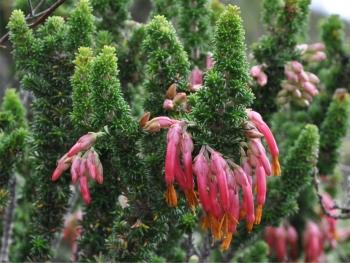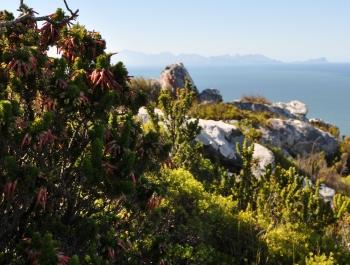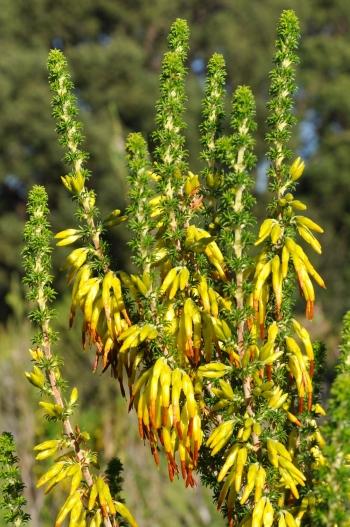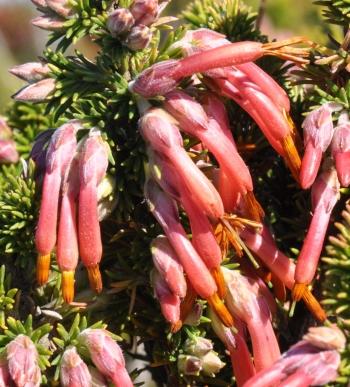Erica coccinea subsp. coccinea
Erica coccinea L. subsp. coccinea
Family: Ericaceae
Common names: tassel heath, small tassel heath (Eng.); hangertjie (Afr.)
Introduction
Erica coccinea subsp. coccinea is a decorative fynbos shrub with large, pendulous tubular flowers, in a range of colours, that attract sunbirds to the garden.

Description
Description
Erica coccinea subsp. coccinea is a rigid, stoutly branched, bushy shrub, up to 1.2 m tall. Hanging tubular flowers are produced in threes, on the ends of short side branches. The flower-bearing side branches are closely packed towards the tips of the upright main branches, giving the effect of a spike-like inflorescence. The anthers are yellow-brown and protrude far from the flower tube. The sepals are coloured, and the bract and bracteoles are enlarged and clasp the calyx.
This is a variable species throughout its range. The length of the flower tubes can vary from ± 16 to 22 mm. The flower tubes may be smooth or hairy, dry or sticky. Flower colour is variable, it can be red, light red, pink, orange, yellow, brownish or green. Flowers are seen throughout the year in different localities. On the Cape Peninsula they flower mainly from autumn until spring (April-August). The leaves can be short, hard and curved, or long, smooth and tightly packed. Also, some plants have an underground rootstock that allows the plant to survive and resprout after a fire, whereas others don't.

In the field, Erica coccinea is most often confused with E. plukenetii, but a closer look makes them easy to tell apart. Firstly, their foliage is different: the leaves of E. plukenetii are longer and curve upward and are arranged in whorls, while those of E. coccinea are shorter and curved downwards and are grouped in bunches or tufts. Secondly, there is a difference in their flowers: in E. coccinea the bract and bracteoles are large, and look like the sepals and are pressed against them (so that it looks like two 'sets' of sepals), whereas in E. plukenetii they are small and insignificant and are placed quite far from the sepals (so you see just the one 'set' of sepals and far down the flower stalk some tiny bracts).
Erica coccinea subsp. uniflora (Single-flowered Tassel Heath), differs from Erica coccinea subsp. coccinea in that the flowers are borne singly (not in threes), they are usually yellow, occasionally orange-red, and it occurs on lowland hills and flats not far from the coast, from the Cape Peninsula eastwards to near Mossel Bay.
Conservation Status
Status
Least Concern (Raimondo et al. 2009). Erica coccinea subsp. coccinea is not threatened.
Distribution and habitat
Distribution description
Erica coccinea subsp. coccinea is widespread and common, and is found growing in a variety of habitats, including rocky flats, rocky outcrops, in rock crevices, on dry sandy flats or on cool wet slopes, on mountains from the Cederberg near Clanwilliam to the Kamanassie Mountains near George, including the Cape Peninsula.

Derivation of name and historical aspects
History
The genus Erica gets its name from ereiko, to break, either because of the ability of the plant to break up bladder stones or more probably because the stems are brittle and break easily. The specific name coccinea means red or scarlet in Latin, and refers to the flower colour of the plant described by Linnaeus. It turns out not to be the best name chosen, as the flower colour is not only red but can be red, orange, yellow or greenish.

Erica coccinea has a rather complicated nomenclatural history. It has been described under different names by different botanists. A number of varieties were recognized, which have now been split into separate species. To add to the confusion, the name E. coccinea was given in error to another, unrelated red erica: E. abietina.
Linnaeus first named Erica coccinea in 1753, then changed his mind and called it Erica petiveri in 1771, by which name it was known for some time. But the rules of nomenclature give the earlier name priority, so Erica coccinea is the correct name. It was also described under the name E. sebana by Donn in 1796.
In 1767 P.J. Bergius described what is now Erica abietina subsp. abietina (red heath) under the name E. coccinea, despite the fact that Linnaeus had already described E. abietina in 1753. Bergius' Erica coccinea was subsequently found to be identical to Linnaeus' Erica abietina, and as E. abietina is the older name, and E. coccinea already applies to a different species, the name Erica abietina stands.
Erica coccinea was until recently regarded as a single variable species with a number of varieties. Oliver & Oliver revised the Erica coccinea complex in 2002. (The Erica coccinea complex contains: Erica coccinea (tassel heath), Erica melastoma (vlakteheide), Erica intermedia and Erica monadelpha.
Erica coccinea now consists of two subspecies: Erica coccinea subsp. coccinea and Erica coccinea subsp. uniflora; and its former varieties have been reclassified as follows:
- Erica coccinea var. intermedia is now Erica intermedia ssp. intermedia.
- Erica coccinea var. inflata is now Erica melastoma ssp. melastoma.
- Erica coccinea var. melastoma is now Erica melastoma ssp. melastoma.
- Erica coccinea var. wildenovii is now Erica melastoma ssp. melastoma.
- Erica coccinea var. pubescens is now Erica coccinea ssp. coccinea.
Erica coccinea var. echiiflora is not a member of the Erica coccinea complex and has two conflicting descriptions:
- Bolus' 1905 description of Erica coccinea var. echiiflora is Erica abietina ssp. diabolis (Devil's Peak red heath).
- Andrews' 1805 description of Erica echiiflora and Bentham's Erica coccinea var. echiiflora are synonymous with Erica viscaria subsp. gallorum.
Ecology
Ecology
Erica coccinea is visited by sunbirds, which feed on the nectar and while doing so, pollinate the flowers. The protruding anthers of Erica coccinea form a tube around the style, which has the effect of increasing the length of the flower. The anthers are joined to form a ring which is broken by the bird's beak as it probes inside to get to the nectar at the base of the flower tube. You can easily tell if a flower has been visited by a bird or not: freshly opened flowers have a single, tidy bunch of brown or yellow anthers at the tip of the tube whereas in a visited flower they are split apart and untidy-looking. As the anthers separate, they dust pollen onto the beaks and foreheads of the birds. At the same time, the stigma, which also protrudes from the flower, picks up pollen from the bird.

The flowers are also visited by bees and other insects that feed on the pollen or steal the nectar by biting holes through the base of the flower tube.
Erica coccinea is unusual in that some plants resprout and some do not. The different types are usually in different populations but sometimes plants growing together in the same population show this difference. Resprouters are multi-stemmed at ground level whereas reseeders are single-stemmed. Fynbos being fire-adapted, most species have evolved either the resprouting or reseeding strategy to survive fires. Resprouters survive the fire thanks to a lignotuber, a swollen stem base with many active buds and thick roots, and send out new growth after the fire. Reseeders are killed by a fire but the population survives by producing copious seeds that are either stored on the bush in pods or cones (serotiny), or carried off and stored by ants (myrmecochory) or dropped to lie dormant in the soil forming a seed bank, and germinate after the fire. Erica coccinea drops its seeds.
Not many species have evolved both strategies. A recent study shows that where the rainfall is reliable, the reseeding and resprouting Erica coccinea types are equally common. But, the resprouting E. coccinea type is more common on inland mountains where the rainfall is less reliable and the summer drought more intense. The reseeders are more vulnerable to erratic rainfall and frequent fires. Also, the reseeder populations have higher genetic diversity within the population and show greater genetic difference between populations when compared to resprouter populations. Resprouters are usually longer-lived than reseeders.
Uses
Use
Erica coccinea is not used in traditional medicine. It is cultivated for the cut flower market.
Growing Erica coccinea subsp. coccinea
Grow
Grow Erica coccinea in well-drained soil, in a position that is sunny or gets morning to midday sun. It prefers a cool position, and fails to thrive in hot, dry positions, particularly those that get the hot afternoon sun. It prefers a well-watered site, but it must be well drained. Grow it in the fynbos garden, the coastal garden, in the cool rockery, on east, southeast- or southwest-facing terraces or where they are shaded for the later part of the day, or in containers. It is relatively long-lived, especially the plants that have a lignotuber. When growing ericas in containers, it is important to use the correct soil. It should be a well-drained, acidic (pH between 5 and 6.5), sandy loam, containing 50% well rotted compost, with no manure or strong fertiliser (use slow release or low doses).
Propagation by seed: Erica coccinea is easily grown from seed. Sow in late summer to autumn (March-May), in well-drained sandy soil. Keep warm and moist. Treatment with Instant Smoke Plus Seed Primer will enhance germination. Use a well-drained, acidic medium. Because the seed is so fine it needs only a light covering of clean sand, or the seeds can be mixed with dry sand and the layer of seed and sand spread in a thin layer on top of the sowing medium. Water with a fine rose to avoid displacing the seeds. Keep the trays damp but not wet and out of direct sun in a warm, but not hot, situation. Germination takes 1 to 2 months. Transplant the seedlings when they are about 10 mm high. Grow on in light shade until they are established.
Propagation by cuttings: Take semi-hardwood heel cuttings in late summer, autumn or spring. Treat with a rooting hormone suitable for semi-hardwood cuttings. Place in well-aerated medium, under mist on heated benches (24°C). Pot the rooted cuttings in a well-drained, acidic soil medium and harden off in light shade for a month or two. Although the species can be propagated by cuttings, because of its short, dense branching habit, it is often difficult to find suitable branches to use. Look for bushes in more shady positions where the growth is more elongated. At Kirstenbosch, we almost always propagate this erica by seed.
References
- Baker, H. A. & Oliver, E. G. H. 1967. Ericas in Southern Africa. Purnell & Sons, Cape Town.
- Oliver, I. & Oliver, T. 2000. Field Guide to the Ericas of the Cape Peninsula. Protea Atlas Project, National Botanical Institute, Cape Town.
- Oliver, E.G.H., and Oliver, I.M. 2002. The genus Erica (Ericaceae) in southern Africa: taxonomic notes 1. Bothalia 32,1: 37-61.
- Plants of southern Africa: an online checklist. http://posa.sanbi.org
- Rebelo, A.G., Siegried, W.R. and Oliver, E.G.H. 1985. Pollination syndromes of Erica species in the south-western Cape. S.Afr.J.Bot.51(4):270-280
- Schumann, D., Kirsten, G. and Oliver, E.G.H. 1992. Ericas of South Africa. Fernwood Press, Cape Town.
- Segarra-Moragues, J.G. & Ojeda, F. 2010. Postfire response and genetic diversity in Erica coccinea: connecting population dynamics and diversification in a biodiversity hotspot. Evolution 64(12): 3511-3524.
- Smith, C.A. 1966. Common names of South African plants. Memoirs of the Botanical Survey of South Africa No. 35.
- Trinder-Smith, T. 2006. Wild Flowers of the Table Mountain National Park. South African Flower Guide 12. Botanical Society of South Africa.
Credits
Alice Notten
Kirstenbosch National Botanical Garden
May 2011
Acknowledgments: The author thanks Anthony Hitchcock, Nursery Manager at Kirstenbosch, for sharing his experience in growing Erica coccinea.
Plant Attributes:
Plant Type: Shrub
SA Distribution: Western Cape
Soil type: Sandy
Flowering season: Spring, Autumn, Winter, Sporadic/All year
PH: Acid
Flower colour: Brown, Green, Red, Pink, Yellow, Orange
Aspect: Full Sun, Morning Sun (Semi Shade)
Gardening skill: Average
Special Features:
Horticultural zones










Rate this article
Article well written and informative
Rate this plant
Is this an interesting plant?
Login to add your Comment
Back to topNot registered yet? Click here to register.